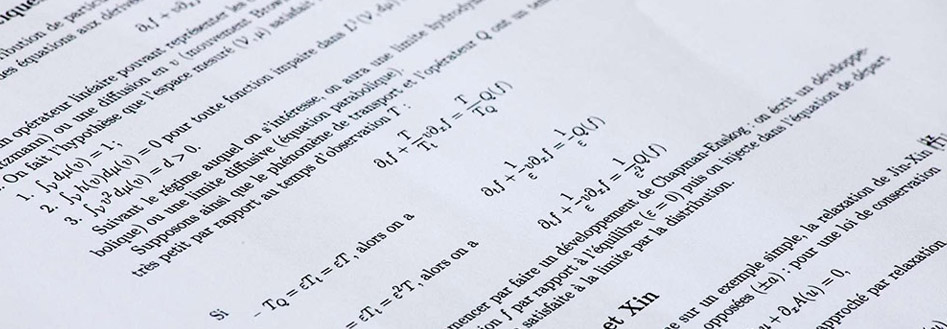
Research Topics
Since November 1, 2015, the laboratory has been known as: Laboratoire Mathématiques et Informatique pour la Complexité et les Systèmes (MICS)
Created in the early 2000s, MICS brings together CentraleSupélec’s research in Mathematics and Computing. At the center of digital technologies, its subjects involve modeling, simulation, analysis and optimization of complex systems, whether from the industrial world, living things, markets or information and networks.
Modeling of Plant Growth
- Modeling and estimation of the dynamic system of plants in their environment
- Formal grammars and identification by symbolic method
- Optimal control of cultures and genetic improvement
- Landscape multiphysics and multi-scale simulation
Partial Differential Equations and Scientific Computing
- Fluid-structure interaction
- Modeling interfaces
- Ecosystem dynamics
- Asymptotic preserving
- Calculation tables
- GPU
- Nonlinear wave equations
Formal Computing and Knowledge Modeling
- Formal engineering for complex systems; ontologies, intelligence and fuzzy logic for image interpretation
- Business intelligence (SAP Research Center)
- Business intelligence and visual analytics
Quantitative Finance (BNP Paribas Research Center)
- Modeling of financial markets
- Microstructure
- High-frequency data
- Econophysics
- Derivatives
Probabilistic Modeling and Uncertainties (including Inria Regularity project team)
- Local regularity of stochastic processes; processes with prescribed regularity
- Set-indexed processes
- Ergodic theory
- Graph statistics and structured data
Biomathematics
- Mathematical modeling of in vitro cell behavior
- Design of experiments and DNA microarray data
- Epidemiology
Fields of Application
- Industrial Systems (aeronautics, building, energy, transportation)
- Environment (plants, hydrology, landscapes, acoustics and noise)
- Health (molecular biology, genomics, epidemiology)
- Markets and companies (finance, business intelligence)
- Computing and networks (Internet, multimedia, knowledge management)
- Art and architecture (colorimetry, architectural reconstruction and virtual reality)
Examples of Work
Scientific Engineering and Visualization
Modeling, simulation and optimization techniques have become essential tools in the analysis and design of products and systems. This research line focuses on complex systems modeled by dynamic systems, optimization and control techniques, and associated pre- and post-treatment environments.Two flagship projects are being developed. The first is Digiplante, in association with Inria, Cirad, AgroParisTech and LIAMA in Beijing, based on the modeling of plant growth from the genome to the landscape. The second is the large multidisciplinary CSDL (Complex System Design Lab) project from the System@tic cluster, where the laboratory coordinates modeling approaches, deterministic or probabilistic simulation, and advanced decisional visualization.
Probabilistic Modeling and Statistics
Probabilistic modeling and modeling from data are two important lines of research. Examples include: 1) quantitative finance and modeling of financial markets from high-frequency data, as part of an industrial chair with BNP Paribas and 2) refined modeling of the regularity of stochastic processes and consideration of uncertainties in the models, in collaboration with Inria.
Information System Architectures
Information systems are evolving rapidly in terms of architectures, as well as operating modes. This topic focuses on new cluster-grid or cloud computing type architectures, architectures and processing of large masses of information, particularly multimedia, in the field of Business Intelligence, as part of a center with SAP-Business Objects, and formal engineering approaches for complex systems. The laboratory is involved in several European initiatives, in particular, EGEE, BEinGRID and Pégase, and HPC parallel architectures are being developed (for example, the Open GPU project)
Scientific Partners
Inria, CEA, ENS Cachan, École Polytechnique, INRA, Cirad, Paris-Sud University, Université de Versailles Saint-Quentin-en-Yvelines, LIAMA, Université de Montréal, ENSI Tunis, Saha Institute of Nuclear Physics, Institut Louis Bachelier.
Key Industrial Partners
-
BNP Paribas, SAP, Alcatel, Bionatics, Bull, ENGIE, Institut Pasteur, CS-SI, Dassault Aviation, EDF, ESI, Orange, Kxen, Myosix, Renault, Thales.
-
Business and Research Clusters: System@tic, Finance Innovation, Cap Digital
- Technopole TER@TEC
Key Figures
- Instructor-researchers and researchers: 21
- Technical and administrative staff: 9
- PhD students: 37
- Post-doc: 10
- Tier A publications (source: Web of Science): 26
- Value of signed contracts (excluding chairs): €827,000
Learn more
Contact
Director: Frédéric Abergel
Tel.: +33 (0)1 41 13 18 95

